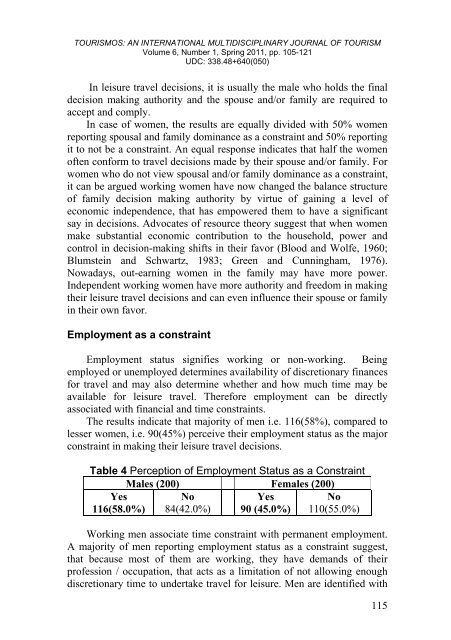GENDERED LEISURE: ARE WOMEN MORE CONSTRAINED IN ...
GENDERED LEISURE: ARE WOMEN MORE CONSTRAINED IN ... GENDERED LEISURE: ARE WOMEN MORE CONSTRAINED IN ...
TOURISMOS: AN INTERNATIONAL MULTIDISCIPLINARY JOURNAL OF TOURISMVolume 6, Number 1, Spring 2011, pp. 105-121UDC: 338.48+640(050)In leisure travel decisions, it is usually the male who holds the finaldecision making authority and the spouse and/or family are required toaccept and comply.In case of women, the results are equally divided with 50% womenreporting spousal and family dominance as a constraint and 50% reportingit to not be a constraint. An equal response indicates that half the womenoften conform to travel decisions made by their spouse and/or family. Forwomen who do not view spousal and/or family dominance as a constraint,it can be argued working women have now changed the balance structureof family decision making authority by virtue of gaining a level ofeconomic independence, that has empowered them to have a significantsay in decisions. Advocates of resource theory suggest that when womenmake substantial economic contribution to the household, power andcontrol in decision-making shifts in their favor (Blood and Wolfe, 1960;Blumstein and Schwartz, 1983; Green and Cunningham, 1976).Nowadays, out-earning women in the family may have more power.Independent working women have more authority and freedom in makingtheir leisure travel decisions and can even influence their spouse or familyin their own favor.Employment as a constraintEmployment status signifies working or non-working. Beingemployed or unemployed determines availability of discretionary financesfor travel and may also determine whether and how much time may beavailable for leisure travel. Therefore employment can be directlyassociated with financial and time constraints.The results indicate that majority of men i.e. 116(58%), compared tolesser women, i.e. 90(45%) perceive their employment status as the majorconstraint in making their leisure travel decisions.Table 4 Perception of Employment Status as a ConstraintMales (200) Females (200)Yes116(58.0%)No84(42.0%)Yes90 (45.0%)No110(55.0%)Working men associate time constraint with permanent employment.A majority of men reporting employment status as a constraint suggest,that because most of them are working, they have demands of theirprofession / occupation, that acts as a limitation of not allowing enoughdiscretionary time to undertake travel for leisure. Men are identified with115
- Page 12 and 13: Sonia Khanthe image the breadwinner
- Page 14 and 15: Sonia KhanBella, L. (1989). Women a
- Page 17: TOURISMOS: AN INTERNATIONAL MULTIDI
TOURISMOS: AN <strong>IN</strong>TERNATIONAL MULTIDISCIPL<strong>IN</strong>ARY JOURNAL OF TOURISMVolume 6, Number 1, Spring 2011, pp. 105-121UDC: 338.48+640(050)In leisure travel decisions, it is usually the male who holds the finaldecision making authority and the spouse and/or family are required toaccept and comply.In case of women, the results are equally divided with 50% womenreporting spousal and family dominance as a constraint and 50% reportingit to not be a constraint. An equal response indicates that half the womenoften conform to travel decisions made by their spouse and/or family. Forwomen who do not view spousal and/or family dominance as a constraint,it can be argued working women have now changed the balance structureof family decision making authority by virtue of gaining a level ofeconomic independence, that has empowered them to have a significantsay in decisions. Advocates of resource theory suggest that when womenmake substantial economic contribution to the household, power andcontrol in decision-making shifts in their favor (Blood and Wolfe, 1960;Blumstein and Schwartz, 1983; Green and Cunningham, 1976).Nowadays, out-earning women in the family may have more power.Independent working women have more authority and freedom in makingtheir leisure travel decisions and can even influence their spouse or familyin their own favor.Employment as a constraintEmployment status signifies working or non-working. Beingemployed or unemployed determines availability of discretionary financesfor travel and may also determine whether and how much time may beavailable for leisure travel. Therefore employment can be directlyassociated with financial and time constraints.The results indicate that majority of men i.e. 116(58%), compared tolesser women, i.e. 90(45%) perceive their employment status as the majorconstraint in making their leisure travel decisions.Table 4 Perception of Employment Status as a ConstraintMales (200) Females (200)Yes116(58.0%)No84(42.0%)Yes90 (45.0%)No110(55.0%)Working men associate time constraint with permanent employment.A majority of men reporting employment status as a constraint suggest,that because most of them are working, they have demands of theirprofession / occupation, that acts as a limitation of not allowing enoughdiscretionary time to undertake travel for leisure. Men are identified with115



